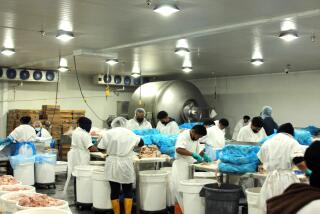Beef Industry Fenced In by Escalating Problems : Food: The meatpackers face low demand, tougher competition from other meat products and a profit squeeze.
- Share via
OMAHA, Neb. — Facing low demand, tougher competition and a profit squeeze, the nation’s beef-packing industry is slicing production and preparing for what some analysts say could be long-term problems.
Beef packing’s Big Three companies--IBP, ConAgra and Cargill --have reduced operating hours or temporarily shut plants in recent weeks.
Among the plants affected: IBP’s beef plants in Lexington, Dakota City and West Point; ConAgra’s Monfort Inc. plants in Grand Island and Des Moines, Iowa, and Cargill’s Excel Corp. plant in Schuyler.
More than 9,500 meatpacking employees in Nebraska and Iowa got unscheduled time off last week.
“You’re selling into a market that frankly is glutted with competing meats,” American Meat Institute economist Jens Knutson told the Omaha World-Herald in a story Sunday.
The institute is a Washington trade association for meatpackers.
Recent losses, estimated at $35 for each animal slaughtered, are the worst for packers since March, 1989, said John Nalivka, executive vice president of Sterling Marketing, a meat industry consulting firm in Lenexa, Kan.
Some industry experts say packers are enduring a down cycle in a topsy-turvy business. But they say meatpackers face some problems that could mean long-term trouble.
Per-capita consumption of beef has declined. The average American ate 78.5 pounds of beef in 1986 and 67.2 pounds in 1991, the experts say.
Industry spokesmen and analysts cite these potential long-term problems for beef packers:
* Relatively low cattle supplies, meaning packers pay higher prices. Overexpansion, debt and low prices drove many cattle producers out of business in the mid-1980s. The size of the U.S. cattle herd dipped from 116 million in 1982 to 98 million in 1989 and has risen only slightly since.
* Too many plants, with the industry having enough plant capacity to slaughter about 25% more cattle than are available.
* Increased competition from pork, chicken, turkey and fish, which challenge beef in the battle for health-conscious consumer dollars.
More to Read
Inside the business of entertainment
The Wide Shot brings you news, analysis and insights on everything from streaming wars to production — and what it all means for the future.
You may occasionally receive promotional content from the Los Angeles Times.










